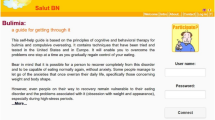Summary
Objective
This study aims to evaluate the long-term outcome of new technology assisted guided self-help in adolescents with bulimia nervosa (BN).
Method
One hundred and twenty-six patients with BN (29 adolescents and 97 adults) were randomly allocated to a cognitive behavioural therapy-based self-help program delivered by the Internet or bibliotherapy, both accompanied by e-mail guidance. Outcomes were assessed at baseline, month 4, 7 and 18 including remission rates and eating disorder associated psychopathology.
Results
In all, 44 % of adolescents vs. 38.7 % of adults were in remission at month 7, and 55 % of adolescents vs. 62.5 % of adults were in remission at follow-up. Objective binge eating and compensatory behaviour improved significantly over time in both groups, with the highest decrease during the first 4 months. A significant decrease over time and no group differences have been found in almost all EDI-2 subscales.
Conclusions
E-mail guided self-help (delivered via the Internet or bibliotherapy) is equally effective for adolescents as for adults with BN, and can be recommended as an initial step of treatment for this younger age group.
Similar content being viewed by others
References
Schmidt U, Lee S, Beecham J, Perkins S, Treasure J, Yi I, et al. A randomised controlled trial of family therapy and cognitive behaviour therapy guided self-care for adolescents with bulimia nervosa and related disorders. Am J Psychiatry. 2007;164:591–8.
Shapiro JR, Berkman ND, Brownley KA, Sedway JA, Lohr KN, Bulik CM. Bulimia nervosa treatment: a systematic review of randomised controlled trials. Int J Eat Disord. 2007;40:321–36.
le Grange D, Crosby RD, Rathouz PJ, Leventhal BL. A randomised controlled comparison of family-based treatment and supportive psychotherapy for adolescent bulimia nervosa. Arch Gen Psychiatry. 2007;64:1049–56.
Pretorius N, Arcelus J, Beecham J, Dawson H, Doherty F, Eisler I, et al. Cognitive-behavioural therapy for adolescents with bulimic symptomatology: the acceptability and effectiveness of internet-based delivery. Behav Res Ther. 2009;47:729–36.
Pretorius N, Rowlands L, Ringwood S, Schmidt U. Young people’s perceptions of and reasons for accessing a web-based cognitive behavioural intervention for bulimia nervosa. Eur Eat Disord Rev. 2010;18:197–206.
Health NCCfM. Core interventions in the treatment and management of anorexia nervosa, bulimia nervosa, and related eating disorders. London: National Institute for Clinical Excellence; 2004.
Bailer U, de Zwaan M, Leisch F, Strnad A, Lennkh-Wolfsberg C, El-Giamal N, et al. Guided self-help versus cognitive-behavioural group therapy in the treatment of bulimia nervosa. Int J Eat Disord. 2004;35:522–37.
Thiels C, Schmidt U, Treasure J, Garthe R, Troop N. Guided self-change for bulimia nervosa incorporating use of a self-care manual. Am J Psychiatry. 1998;155:947–53.
Carrard I, Fernandez-Aranda F, Lam T, Nevonen L, Liwowsky I, Volkart AC, et al. Evaluation of a guided internet self-treatment programme for bulimia nervosa in several European countries. Eur Eat Disord Rev. 2010. (Epub ahead of print).
Fernandez-Aranda F, Nunez A, Martinez C, Krug I, Cappozzo M, Carrard I, et al. Internet-based cognitive-behavioral therapy for bulimia nervosa: a controlled study. Cyberpsychol Behav. 2009;12:37–41.
Sanchez-Ortiz VC, Munro C, Stahl D, House J, Startup H, Treasure J, et al. A randomised controlled trial of internet-based cognitive-behavioural therapy for bulimia nervosa or related disorders in a student population. Psychol Med. 2011;41:407–17.
Schmidt U, Andiappan M, Grover M, Robinson S, Perkins S, Dugmore O, et al. Randomised controlled trial of CD-ROM-based cognitive-behavioural self-care for bulimia nervosa. Br J Psychiatry. 2008;193:493–500.
Ruwaard J, Lange A, Broeksteeg J, Renteria-Agirre A, Schrieken B, Dolan CV, et al. Online cognitive-behavioural treatment of bulimic symptoms: a randomised controlled trial. Clin Psychol Psychother. 2012. (Epub ahead of print).
Carrard I, Rouget P, Fernandez-Aranda F, Volkart AC, Damoiseau M, Lam T. Evaluation and deployment of evidence based patient self-management support program for Bulimia Nervosa. Int J Med Inform. 2006;75:101–9.
Wagner G, Penelo E, Wanner C, Gwinner P, Trofaier M, Imgart H, et al. Internet delivered cognitive behavioural therapy vs. conventional guided self-help in the treatment of bulimia nervosa: long-term evaluation of a randomised controlled trial. Br J Psychiatry. 2013;202:135–41.
Treasure J, Schmidt U. Getting Better Bit(e) by Bit(e). Hove: Lawrence Erlbaum Associates; 1993.
Garner DM, Olmsted MP. More on the eating disorder inventory. Am J Psychiatry. 1986;143:805–6.
Rathner G, Rumpold G. Convergent validity of the eating disorder inventory and the anorexia nervosa inventory for self-rating in an Austrian non-clinical population. Int J Eat Disord. 1994;16:381–93.
Andersson G, Waara J, Jonsson U, Malmaeus F, Carlbring P, Ost LG. Internet-based self-help versus one-session exposure in the treatment of spider phobia: a randomised controlled trial. Cogn Behav Ther. 2009;38:114–20.
Sanchez-Ortiz VC, Munro C, Startup H, Treasure J, Schmidt U. The role of email guidance in internet-based cognitive-behavioural self-care treatment for bulimia nervosa. Eur Eat Disord Rev. 2011;19:342–8.
Sanchez-Oriz VC, House J, Munro C, Treaute J, Startup H, Williams C, Schmidt U. A computer isn’t gonna judge you: a qualitative study of users’ views of an internet-based cognitive behavioural guided self-care treatment package for bulimia nervosa and related disorders. Eat Weight Disord. 2011;16:93–101.
Varchol L, Cooper H. Psychotherapy approaches for adolescents with eating disorders. Curr Opin Pediatr. 2009;21:457–64.
Conflict of interest
This study was supported in part, by a grant from the Jubilaeumsfonds of the Austrian National Bank (AP11957).
Author information
Authors and Affiliations
Corresponding author
Rights and permissions
About this article
Cite this article
Wagner, G., Wagner, G., Penelo, E. et al. Is technology assisted guided self-help successful in treating female adolescents with bulimia nervosa?. Neuropsychiatr 27, 66–73 (2013). https://doi.org/10.1007/s40211-013-0062-x
Received:
Accepted:
Published:
Issue Date:
DOI: https://doi.org/10.1007/s40211-013-0062-x




